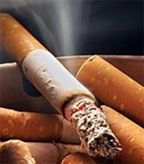Smoking Immediately After Waking Correlates With Higher Carcinogen Levels
The faster one smokes a cigarette after waking in the morning, the higher the biologic exposure to an important tobacco-related carcinogen, according to a new study. Time to first cigarette, or TTFC, could be a useful marker of high lung cancer risk among smokers as a result.
The faster one smokes a cigarette after waking in the morning, the higher the biologic exposure to an important tobacco-related carcinogen, according to a new study. Time to first cigarette, or TTFC, could be a useful marker of high lung cancer risk among smokers as a result.

“We found that smokers who consume cigarettes immediately after waking have higher levels of NNAL-a metabolite of the tobacco-specific carcinogen NNK-in their blood than smokers who refrain from smoking a half hour or more after waking, regardless of how many cigarettes they smoke per day,” said study lead author Steven A. Branstetter, PhD, of Penn State University, in a press release. Previous studies have shown higher cotinine levels and increased cancer risk in early smokers, but have not elucidated the mechanism for that higher risk.
The study examined data from 1,945 participants in the National Health and Nutrition Examination Survey (NHANES), looking in particular at levels of creatinine-adjusted urinary 4-(methylnitrosamino)-1-(3-pyridyl)-1-butanol, or NNAL.
Among all smokers, 32.4% smoked the first cigarette within 5 minutes of waking and 31.3% smoked between 6 and 30 minutes after waking; 17.7% waited between 31 and 60 minutes to smoke, and 18.5% smoked more than an hour after waking up. NNAL levels were significantly correlated with a number of variables, including age, age at which one began smoking regularly, number of days smoked in the previous 30, creatinine levels, and TTFC.
ANOVA modeling showed that those who smoked within 5 minutes of waking were significantly more likely to have higher NNAL levels (P < .001). The relationship between NNAL and TTFC was linear, with each successive time point correlating with lower NNAL levels. A second model that controlled for cigarettes smoked per day, cotinine, and creatinine still found significantly higher NNAL levels in those that smoked immediately after waking (P < .001).
“We believe these people who smoke sooner after waking inhale more deeply and more thoroughly, which could explain the higher levels of NNAL in their blood, as well as their higher risk of developing oral or lung cancer,” Branstetter said. “As a result, time to first cigarette might be an important factor in the identification of high-risk smokers and in the development of interventions targeted toward early-morning smokers.”
Study Details
The average age of participants in the cohort was 44.82 years, and the mean duration of smoking was 27.28 years. Most of the cohort was non-Hispanic white (55.1%), followed by black (22.7%), Mexican American (10.5%), and other ethnicities. White participants were more likely to smoke immediately after waking than other ethnic groups, and Mexican Americans were more likely to smoke later than the other groups.